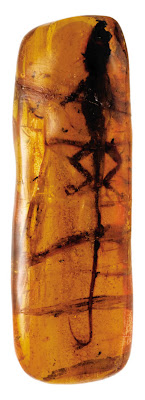I originally wanted to write a response to the discussion that I have been having with an anonymous individual wrt his/her opinion about the methane calthrates having caused the Permian Extinction. And the Cretaceous Extinction. And others. This is the so-called Methane Calthrate Gun Hypothesis. When I first engaged the poster, I held out that maybe there was something that he (or she) knew that I did not and that their anon posting was a desire to cover for their position: as a note, anon posting for those that read this is very off putting and based on past experience is 99% of the time just a cover for stupidity. I like said, however, I do tend to like to listen now and again to those with commentaries about the Imperial Apparel situation...but some times that leads me into tolerating more than I ought. There's a time and a place for evisceration. I had planned that for tonight.
However, that won't be the post for tonight. The gutting will wait for later.
Unfortunately, I had a mild distraction. That distraction is the cheese that is sitting in the fridge. It's a Cotswold. A yummy Cotswold with garlic and onion. I've thought about doing a post on cheeses for a while. My wife is something of a cheese nut and I've been enjoying the ride.
We normally shop at Trader Joe's for our dairy products, but occasionally will pick them up at Whole Foods and Berkeley Bowl. I grew up with the standard cheeses: cheddar, jack, Romano, mozzarella, and Parmesan. Nothing really exciting save for the singular time that my father brought home some truly pungent Limberger! Holy frak!
That said, Lyuda has a definitely far more regined palate when it comes to cheeses. She tends to have a preference for soft or blue cheeses. Bree, an oozing, uber creamy Bree, is one of her favorites. However, I've found several that I rather like. They are not always still available. However, I'll do a run through all the same.
The first is that Cotswold that is currently available from TJs. It's really good. It's also an endangered species atm in the fridge. We've also fallen in love with a Danish Blue: I'm not much of a blue fan, but this one is striking and then some. For a looooong time we were hooked on a smoked Monterrey Jack: it was equally amazing. It looked really bad, but tasted oh-so good. Finally, there was this Moroccan Spiced Cheddar, oil and pimentos, several spices that I've only heard of but not tasted til then. Wow.
Unfortunately, the smoked Jack and spiced Cheddar are no longer available at TJ's and I've not seen them elsewhere. :(
We have hit up a local creamery a few times. Up in Marin is the Cowgirl Creamery. It has a shop up in Point Reyes and another over at the Ferry Building (the nicely reopened one) in SF proper. East Bayers, hop the BART to the Embarcaderro and it's right there. There are also a number of rather good food shops besides that one. It's a foodie mall. lol. Anyways, the CGC is okay as far as I am concerned, but Lyuda really likes it.
Anyways, yes, I am tired. Too much rocket, HPC, and little kiddo. Not to mention spouse and just keeping up with the day-in, day-out everything else has been a little overwhelming as well.
Oh, one more commercial bit from TJ's: They have Hatch Green Chile now. Roasted and in a can like the Ortega stuff, milder than water, but it has the exquisite taste of back home if not the fire (this is California and the lot of them are terrified of a mild chile, witness that abomination they call the Anaheim). I've been eating it straight with cottage cheese (woo! tie back!), serving with eggs, and a bunch more. It's been great to taste home a bit without spending an arm and a leg. So go buy some if your TJ's is close by. I want this item to have a long and happy life on TJ's shelves.
What? Don't really know how to use it? Lemme give you an example:
Take a frying pan and melt a pat of butter. Preferably more than enough to cover the bottom of your pan. Place on medium. Sprinkle in garlic (granules are best, but powder works), sage, and black pepper. Let it infuse the butter. Take chicken breast and rub with salt and pepper. Then place the breast in the pan and cover. Flip a few times. Throw in about a quarter of a diced onion and 3 sliced mushrooms. Saute. When the mushrooms are almost ready, squeeze in a 1/4 to 1/2 of a juicy lime. I normally sprinkle a little more salt in. Then cover. Wait until a good chunk of the lime juice is evaporated and then add a 1/4 to 1/2 can of the Hatch Green Chile. Turn up the heat and brown the chicken a bit, but don't over cook the chile. It ought to pop a few times and be consistently hot. Remove from heat. Remove chicken from pan and place on plate. Remove mushrooms, onions and chile. Place atop the chicken. Grate Jack cheese over the chicken and chile+ admixture. Serve.
Can be done w/o the mushrooms, but must have the onions and chile. You can reduce the lime, but don't eliminate it. Good combo! Lime, chile, garlic, sage, and mushrooms (and onion too).
Anyways, cheese and chile. And I need to hit the sack. I'm getting up in a few hours. oy.




























